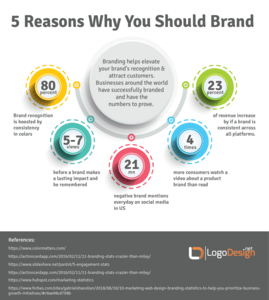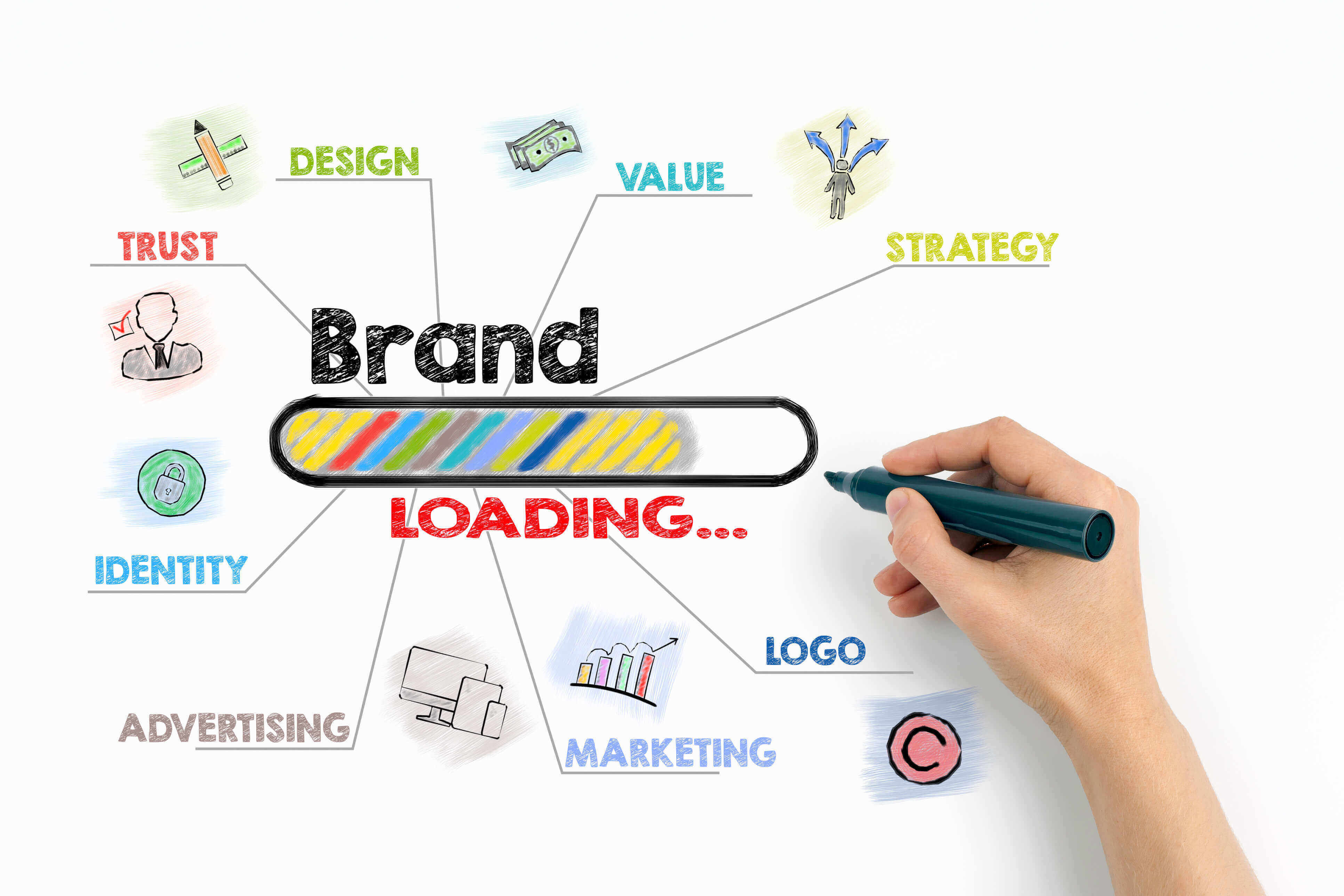
- All
- Accounting & CPA
- Advertising
- Agriculture
- Alphabets
- Animal & Pet
- Apparel & Fashion
- Arts
- Attorney & Law Firm
- Auto & Transportation
- Beauty
- Childcare
- Cleaning
- Communication & Media
- Community & Foundation

No, we aren't just talking about the literal words that might be included, such as in a wordmark logo. We’re talking about other ways of sending messages — specifically, the psychology of colors and how it influences how your logo is viewed and received.
In today’s world, it seems that everything is a competition.
That most certainly includes the world of business. Whether you’re working with a company or opening one yourself; regardless of how big or how small the concern is; and how much or how little experience you bring to the table, it’s going to take every effort to get the edge over the competition.
For the success of any given company, branding is absolutely essential.
Let's talk about what branding is, why it’s important, how to do it, and what it can mean for your business.
Unless you're already conversant with the intricacies of marketing, you might simply point to a business logo or it’s name as an example of a brand.
And you'd be right, sort of. But there’s way, way more to it than that. So let’s get to the specifics.
It isn't just about the brand; it’s about the branding.
A brand is defined in several different ways. According to marketing author Philip Kotler "A brand is a name, term, sign, symbol, or design or a combination of them, intended to identify the goods and services of one seller or group of sellers and to differentiate them from those of the competitor."

Source: istock.com/filo
That sounds a little dry, of course. There’s a more emotional aspect to brands, as well. As a representative of a company, the logo (and other visual components of a brand, such as a monogram or emblem design) should trigger associations in the minds of the viewer. Positive associations, ideally.
Says marketer Jay Baer of Convince and Convert, "Branding is the art of aligning what you want people to think about your company with what people actually do think about your company. And vice-versa.”
And as marketer Ashley Friedlein of Ecoconsultancy.com put it, "Brand is the sum total of how someone perceives a particular organization. Branding is about shaping that perception."

Source: istock.com/vectorplusb
Obviously, this is more complicated than just a trademarked symbol. But why should we pay attention to the process? What benefits does it bring?
Whether you put effort into branding or not, it will happen, even if only organically or by osmosis. Since branding involves the experience that a customer has with a company, as long as the company is in business, it’s adding to — or detracting from — the reputation of its brand, every day, with every interaction.
If you’ve had a bad customer service experience, where your concerns were ignored or not heard at all, you know how lack of attention to branding can harm a business.
It can also be done badly, but we'll address that later.
For now, let's talk about the benefits of branding
Designer Lisa Cron says, "Good branding elevates a business and builds recognition and loyalty." Every business has a message and a mission; branding is a way to communicate that to the viewer. It gives the business a platform from which to speak, reaching out to the intended audience.

A case in point is the example of Airbnb, with its 2014 rebranding.
Founded in 2007, the original brand was focused on giving its customers an easy, cheaper, more convenient way to rent when on vacation, as well as offering those who used it and put their places up for rent a chance to make some money.
There wasn't much in the way of branding done, apart from a choice of logo and font.
However, as the online community grew and the number of users went up, a significant rebrand was decided upon, and the mission of the company was re-assessed.

Source: istock.com/stockcam
CEO Brian Chesky stated, "For so long, people thought Airbnb was about renting houses. But really, we’re about home...Belonging is the idea that defines Airbnb, but the way we’ve represented Airbnb to the world until now hasn’t fully captured this." - The Branding Journal
With the reassessment of the mission and message, a rebranding initiative was rolled out across all platforms, from the website, to the mobile app, to advertising, to the way that the company interacted with its customers.
Significant changes included updates in the logo, color scheme, font choice, interactive options for the customers, visuals and visual guidelines, marketing techniques, social media platforms, and website. Every aspect of the brand was re-aligned to fit in, creating a cohesive, harmonious whole.

Source: istock.com/GoodLifeStudio
What was the upshot of the branding? According to marketing firm Alder and Alder ,"Within 2 years of the rebrand revenue at Airbnb increased by 80%." Alder and Alder also points out that "The continued growth and success of the company is not the result of a new logo...the rebrand allowed the company to project a new image and fulfil their global potential."
Clearly, branding can make a big difference in continued success and growth of a company.
Where else can branding be employed?
Branding isn't just a matter of making sure a company’s brand is on-message and marketed well. It also covers other arenas.
Let's take a look at some other types of branding.
Personal branding is all about personal brand identity; it's geared toward establishing an individual as a brand rather than a company.
Think of a doctor as an example. The doctor has her own individual practice, but she also works two days a week in a clinic with others. Her branding for her individual workplace will be different than the brand identity for the medical clinic; it will be designed to reflect who she is, what she offers as a specialist, and who her target audience is.


This involves the parent company brand, used in conjunction with the release of new lines, products, imprints, or affiliates.
Take publishing giant Penguin Random House as an example. Penguin Random House is the corporate brand, which covers everything from the distinctive logo with a penguin to the reputation of the company as a whole. The brand has nearly 275 different imprints, such as Penguin Classics and Doubleday.
Each of the imprints must align with the overall brand of the corporation.
This type of branding covers the affiliates or subsets of the parent company. A good example is Coca Cola. Diet Coke is still easily identified as belonging to the same line as Coca Cola classic; Coca Cola also owns Sprite, however, which has a completely different brand, look, and audience, although it still bears the letter based logo of the parent company on its packaging.

Source: istock.com/VikiVector
The ones mentioned above are the most commonly thought of, but there are other types of brands that are growing in popularity and need consideration.
Good branding, especially the visual aspects such as logo design, will take into consideration the appeal of the brand in other locations.
This can mean something as simple as researching the psychology of logo colors — certain colors mean different things in different places. For example, the color yellow is commonly seen as warm and friendly in North America; in Latin America, however, it can be seen as the color of mourning and death.
Even within countries, branding may differ. The branding for Dreyer’s ice cream, as an example, goes by the name Edy’s on the east coast of the United States, although the colors and basic design are consistent across the company.
It isn't just individuals and corporations that can leverage branding for their benefit; even entire countries subscribe to the branding ideology.
National branding involves everything from the flag, to the national logo, to official websites, to governmental authorities, to tourism and promotion.
Basically, anything can be a brand; and anything that is a brand, can be branded. Whether it’s done well or poorly, however, is up to the person behind it.

Source: istock.com/chokkicx
Let's take a look at how to execute an effective branding strategy.
What's In A Branding Strategy?
It isn't enough just to run into the whole branding ideology haphazardly. Branding isn’t just a matter of creating a customized logo design, throwing messages, visuals, and user experiences at the wall to see what sticks.
Branding is about setting goals, and creating a strategy that will help you to reach those goals.
Branding strategies don't seek to guarantee statisticity — they're based on the idea that growth is inevitable, and positive growth is a choice.
Scott Lerman, a branding expert who founded Lucid Brands, notes that branding strategies are about guiding "the evolution of a brand in a way that returns to the clarity and focus of its founding, while leveraging hard-won scale and diversity."

Source: istock.com/Olga_Belova
He also breaks down the elements of good branding strategies into what they aim to do: create identity, reinforce familiarity, define the arena in which the brand competes, build the brand character, and promote positive experiences.
All of those are the guiding principles behind good branding strategies. But what does a strategy actually include?

Source: istock.com/exdez
How brand strategy is actually executed depends on the market your company is in. But regardless of the arena in which you compete, setting goals and taking steps is the basis for any successful brand.
Some of these are going to seem incredibly simple — practically no-brainers. But there are reasons behind them.
Lack of focus on customer service and customer experience.
Your brand is more than just the sum of its parts — it's also what it does for others, and the emotions they feel when they're presented with your brand.
If customer service isn't a feature — or if it’s just done poorly, or your customer is given only a token acknowledgement or
Source: istock.com/KakigoriStudio
consideration — that will make a lasting impact on how your customer views your brand as a whole, and it will change their level of loyalty to the brand.
Source: istock.com/miakievy
Not doing market research, or ignoring market research.
There's a reason why market research is advocated both when a business is first getting started, and all along the line as the business continues to grow.
Getting feedback from your audience, finding out what is needed and what isn’t, what works and what doesn’t, can trim the fat from what you offer, allowing you to put emphasis on what brings you new clients and strengthens the relationships you have with existing ones.
Too much or too flagrant self-promotion.
Nobody likes the guy at work who's always talking himself up. Don’t let your brand be that guy.
This may make marketing a challenge, but it's worth finding the balance between personality and simply a marketing machine. "45% of consumers will unfollow a brand on social media if their platform is dominated by self-promotion," says BuzzStream.
You know the answer to this, right?
Those are the basics, the fundamental building blocks of successful branding. But there are other, more specific aspects in play.
Let's cover a few of them.

Source: istock.com/Mykyta Dolmatov
Some brands are so iconic that just the image of the logo, without the name or any other identifier, immediately triggers recognition and a flood of associative emotion in the viewer.
Of course, it isn't about just the visual representation, but here are a few that have used their logos to leverage a memorable, lasting impression on their audience.
It's not hard to picture the Apple logo in your mind, even though it has gone through several color variations over the years. It also tends to trigger very for-or-against reactions.

Source: istock.com/Seremin
Those who love Apple will defend it to the death for its responsiveness, its cutting-edge designs, and its customer communication. Those who have trouble with the air of exclusivity that Apple seems to promote, as well as its heftier price tags, may react immediately with a negative emotion.
Google is another example of an Internet company logo that is very simple: a wordmark in basic font with bright primary colors.
But Google has demonstrated a mastery of branding across platforms, focusing on responsive design and interaction with its users, including a range of temporary logo designs that reflect the occasion, current happenings, or user contributions.

Source: istock.com/rvolkan
The technology company logo is simple, and the rotating designs give the branding as a whole a feeling of whimsy that works well in attracting users.
If you’ve ever told a joke about trying to follow an instruction manual, it probably included the name "Ikea" somewhere along the line.
Of course, becoming part of a punchline isn't the normal aim of a branding strategy — very rarely is that the goal that a company is looking for. But it does illustrate how Ikea has pervaded the public consciousness.
The logo itself is simple — a wordmark with plain block blue letters in a yellow oval logo superimposed on a blue rectangle. It’s instantly recognizable, easily replicated, and very memorable, to the point that it stands out in a crowd.

Source: istock.com/virtualphoto
For instance, when I visited La Romana, Dominican Republic, I was surrounded by brands, logos, and names that I didn't recognize. Then suddenly, the local Ikea store materialized, so familiar and instantly known that it looked supremely out of place.
But I knew exactly what to expect when I went inside, even though I was in a completely different country about which I knew next to nothing.
That's the power of branding: consistency, regardless of where, when, how, or why.
Now that you've found out almost everything you need to know about branding, from what it is to why you should do it, what about specifics on what to do?
Though color theory governs how colors are typically chosen, especially when they are being mixed together or used alongside each other, the psychology of color has a part in the choice as well.
When using a color wheel to choose the colors for your logo, looking for color harmony is an important consideration — not just the harmony of the colors, but also the harmony of the message the colors present.
Though color psychology may not be a guarantee of the success of a design decision, if you do your research and know who your audience is, it can definitely give you a leg up when it comes to a memorable, durable, unique logo design.

Source: istock.com/tumsasedgars
Here's a simple checklist of branding basics.
So what is a brand? It's everything: the logo, the marketing materials, the customer experience, the services offered, the company's employees, everything.
Branding isn't easy. It takes a plan, a strategy, and a progressive series of steps and efforts to get to where you want to be. It also requires a clear vision and determination to take your business straight on through.
But it's definitely worth it.
"Successful branding yields benefits such as increased customer loyalty, an improved image, and a relatable identity,” says TSL Marketing.
And marketing research firm Circle Research states, “77% of B2B marketing leaders say branding is critical to growth.”
So branding really is all about the journey — for you, for your company, and for your customers both new and returning.
With all of this information about successful branding under your belt, here’s hoping that your own branding journey will yield the results you want, and create your own readily identifiable story of success.